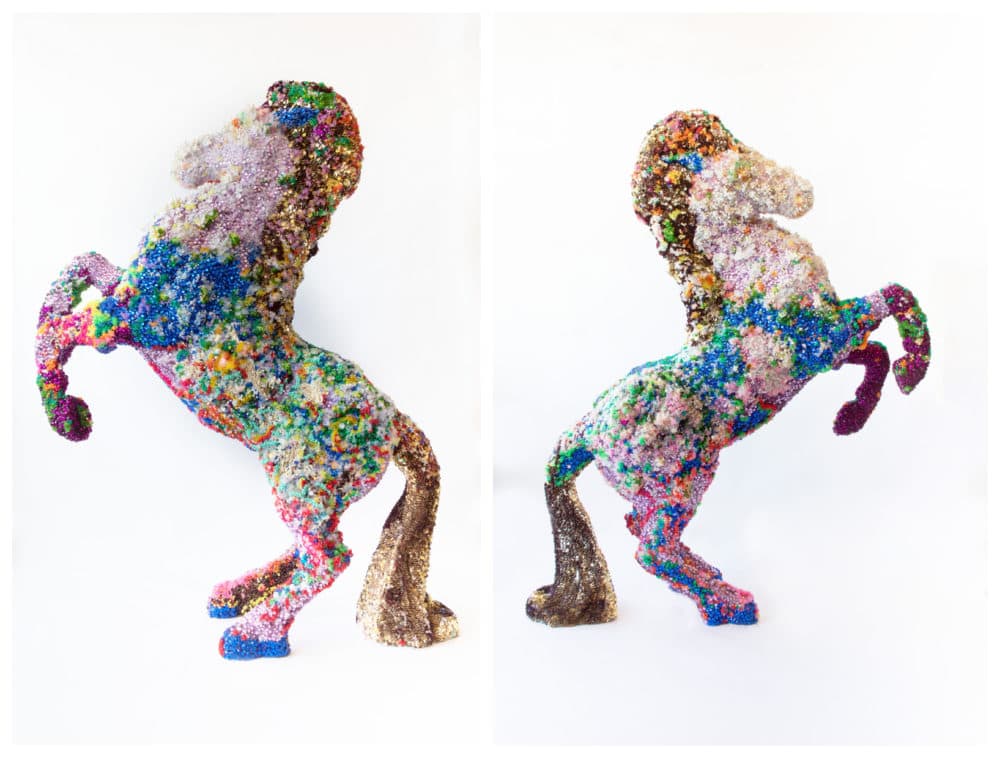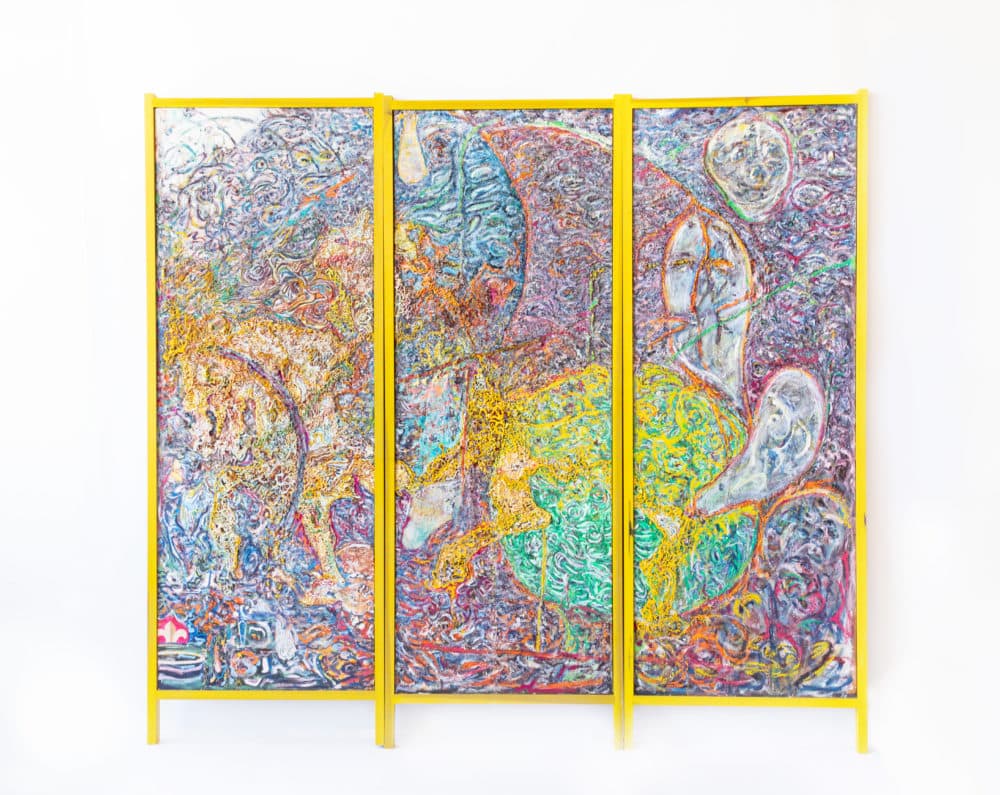A while back, New York artist Raúl de Nieves had a tarot card reading in which he was advised to “become the ruler of his own house.”
“I'm still kind of trying to figure out what that means,” he says. “I think it's quite beautiful to just kind of ask yourself, ‘how do you become the ruler of your own house? What does it mean to be a ruler and what are the responsibilities that come with that?’”
That counsel led de Nieves back to his own past to reconsider his life, his art, his memories. Now, in the exhibit “The Treasure House of Memory,” opening Sept. 1 at the Institute of Contemporary Art (ICA), de Nieves uses his characteristic vivid color and bead-encrusted forms, along with tarot-like allegory, to plumb the meaning and memories embedded deep within his own creative life.
Born in Mexico and now working out of a studio in Bushwick, de Nieves is known for his adorned sculptures coated with plastic beads, bangles, bells and sequins, inspired by both the colorful clothing he remembers as a young boy in Mexico, as well as the elaborate costumes he’s encountered as an adult in the drag ball culture of San Francisco and New York. Vibrant, large scale and often life-size, his work walks the thinnest of lines between the sacred and the bawdy. One painting recalls the solemnity of a church altar panel, another sculpture, sporting playful stiletto heels, speaks more of a seductive sashay down a catwalk. There’s plenty of bling for quick-impact visual appeal, but something deeper lurks here too — allusions to mythology, folk tales as well as possibilities for personal and spiritual transformation.

There are eight pieces in the show and at least five involve horses. De Nieves has created three “mares” — beaded horses that might best be described as a reverse centaur. The figures bear the head of a horse and the legs of a human wearing stilettos. Always in a state of becoming, one “mare” does a back flip, another appears to be on its knees, while a third holds its feet akimbo. The titles — “The Mare of Threes,” “The Mare of Nines” and “The Mare of Thirty-Threes” — cryptically allude to critical ages in de Nieves’ life. At age three, de Nieves lost his father. At nine, he moved to the United States from Mexico with his mother and two brothers. De Nieves’ father passed away at the age of 33, leaving him to wonder if he himself would ever make it to 34. Also, 33 was the age at which Christ died and was resurrected.
“I wanted to use those numbers as forms of inspiration,” he says. “Let that be a source of something that generates more and more questions in my mind that don't necessarily need to be answered. I'm constantly trying to find things that I can ask that don't necessarily need an immediate answer. That's the beauty of the tarot… through the symbolism, there's an aspect of interpretation. But it's up to you to see that interpretation evolve through experience.”
In short, life evolves and the meaning we attach to any one moment changes as we ourselves change. It is a never-ending process of transmutation, perhaps best illustrated by de Nieves’ piece “The Abyss,” in which another horse-like figure has morphed so completely it becomes entirely abstract.
Similarly, de Nieves’ circular collage “Leap Into the Sun” lovingly fashioned of fake flowers, plastic toys, yarn, fabric, cultured pearls and shredded paper, symbolizes what the artist calls “the vortex of the unknown...like wanting to just put everything in a blender in order for it to build its own new life.”
In another painting, de Nieves revisits a personal obsession of his — the legend of St. George and the Dragon, a theme he has returned to dozens of times throughout his career. In the legend, St. George, the patron saint of England, arrives in a village where the populace is being terrorized by a dragon who is demanding a sacrifice of a sheep a day to quell his raging hunger. When the last sheep has been sacrificed, the king decrees that children are next. A child is selected each day by lottery until finally the king’s daughter is up next. Horrified, St. George offers to slay the beast, which he dispenses quickly via a piercing lance to the armpit. In de Nieves’ version of the story, the dragon is no dragon at all, but just an everyday unimpressive snake with no formidable power. St. George shows the villagers what they’ve so feared, admonishing them to deal with their demons (or dragons) and get on with the business of solving real problems.

“I use the story of St. George and the Dragon constantly in my work because I feel like what I've learned from this fable is that it asks a lot of questions in my mind of the characters involved...the horse, the dragon, the victim — and sometimes you have to put yourself in all perspectives in order to see what the actual outcome is.”
We’ve all been the victim, but we’ve all been the dragon too.
The idea of “mastering one’s house” is an idea woven through the show in multiple ways, says show curator Jeffrey De Blois. First, there is the idea of becoming the master of one’s own house, in the sense of making order of things you’ve done and believe. “Then, there’s the house in the Zodiac, there’s the house in drag and ballroom culture, and this idea of the fashion house,” he says.
In the end, de Nieves describes his latest work as a kind of “topographical map” of the unknown, a journey his characters, as well as all of us, must make. It’s about memory, metaphor and metamorphosis, and where it all ends, none of us really knows.
“Raúl de Nieves: The Treasure House of Memory” opens at the ICA Sept. 1 and runs through July 24, 2022.
"artist" - Google News
August 30, 2021 at 04:07PM
https://ift.tt/3BliNvK
At The ICA, Artist Raúl De Nieves Investigates Memory And Mastery - WBUR
"artist" - Google News
https://ift.tt/2FwLdIu
Bagikan Berita Ini














0 Response to "At The ICA, Artist Raúl De Nieves Investigates Memory And Mastery - WBUR"
Post a Comment